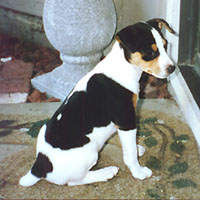All Dogs Need Love
.. . . |
|
I took Jasper to the dog park on my lunch
hour today
and he was playing with a dog that looked like Peetie from the Little
Rascals. She was really cute!!! Her owner said he rescued her from a shelter
when she was 5 mos old. Apparently someone dropped her off there after
finding out she was born deaf. Isn't that sad? Anyhow, he and his wife
paid for private training lessons for her so she could respond to hand
signals and what a smart dog she has become! Susan Connor CA
|
Training For Deaf Dogs is Available
Although deafness is not a defect that is seen in the Rat Terrier breed,
should this tragically happen to anyone here are some quidelines for training.
How to Teach a Deaf Dog Basic Commands by Shelly Bellamy
Training a deaf dog is challenging and takes patience, but it can be
rewarding for both you and your dog; it will also improve your dog's life.
Teaching the "Sit" Command
Steps:
1. Bend your arm at the elbow (at a 90-degree angle) with your
hand held open, palm facing up. Slowly raise your palm toward your shoulder.
2. Hold a tasty-smelling food treat next to your dog's nose and mouth
at the same time as you give the command.
3. Keep the food treat close to your dog's nose, and slowly take the
treat up and over his head. Doing so will lead the dog into a sit.
4. Let your pet nibble on the treat if he wishes, but hold tight as
you lure him into position.
5. Give the food treat the instant your dog sits, and praise him by
petting and making an expressive happy face.
6. Encourage your dog with treats as well as with visual and tactile
reinforcement - you don't want him to give up.
Teaching the "Down" Command
Steps:
1. Start with your dog in the sit position.
2. Bend your arm at the elbow (at a 90-degree angle) with your hand
held open, palm facing down. Slowly lower your hand down by your side.
3. Hold a tasty-smelling food treat next to your dog's nose and mouth
at the same time you give the command, as before.
4. Keep the food treat close to your pet's nose, and slowly take the
treat down to the ground between his legs. This should lure your dog into
the down position.
5. Give the food treat and ample praise when the trick is accomplished.
Tips:
When you first teach this command, start with your hand held level
with the dog or just above his head.
"Down" is a hard behavior to teach to some dogs, as it's the most vulnerable
position a dog can be in. Be patient, and try this over and over until
you both get it right.
Teaching the "Come" Command
Steps:
1. Start inside the house and begin working over a very short distance
(a few feet).
2. Page the dog to get its attention if you have a pager collar, or
wait until your pet notices you.
3. Show a treat when your dog looks at you, and give the hand signal
for "come" by extending your arm straight up.
4. Reward your dog when he comes to you.
Overall Tips:
Teach new behaviors in a familiar area in the
house and on a surface where the dog feels secure, but keep in mind that
dogs are situational learners; after they've learned a particular behavior
in the house, you have to start over when moving outside.
In the beginning, reward your dog as soon
as he shows any attempt to do the behavior (for instance, almost going
into the down position).
Build on these basic behaviors by teaching
"sit," "down" and "come" at a distance. Increase distance slowly, a few
feet at a time.
Refer to basic obedience training manuals
to get ideas for additional hand signals and their proper executions.
Overall Warnings:
If you think your dog has forgotten a particular
behavior, he probably didn't know it well in the first place. Go back and
teach the behavior from the beginning.
Avoid getting angry, jerking, hitting or pushing your pet for unwanted
behavior. Instead, ignore it and focus on rewarding the behavior you do
want.
.
BACK TO INDEX
 .
.